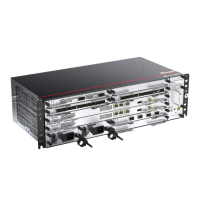
Do you have a question about the Huawei V300R005 and is the answer not in the manual?
| Brand | Huawei |
|---|---|
| Model | V300R005 |
| Category | Network Router |
| Language | English |
Describes the hardware, software architecture, and overview of the NE80.
Details the MPU, LPU, and Service Board components of the NE80 hardware.
Explains the system software architecture, including NMS, RPS, FSU, EFU, and DRV modules.
Outlines key features like flattened network architecture, line-speed forwarding, multiple interfaces, availability, services, QoS, security, and NMS.
Lists the attributes and descriptions of NE80 features, including protocols and security.
Describes working modes for establishing configuration environments via Console, Telnet, and AUX.
Details establishing configuration via console, including tasks, connection, and terminal setup.
Explains remote configuration via Telnet, covering task establishment and login procedures.
Describes remote configuration via AUX port, including modem setup and connection.
Provides examples for logging in through Console, Telnet, and AUX ports.
Covers CLI basics, including interface, levels, views, online help, and features.
Details CLI features like editing, displaying, regular expressions, and history commands.
Explains classification, definition, and usage of CLI shortcut keys.
Provides examples for using shortcut keys and the Tab key in CLI.
Describes the necessity of basic configurations for operation and maintenance.
Details setting up the system environment, including language, hostname, and clock.
Covers configuring user environment, including passwords, user levels, and interface locking.
Explains how to display system configuration, status, and diagnostic information.
Covers user interface views and basic user management concepts.
Details console interface configuration, including attributes, terminal settings, priority, and authentication.
Explains AUX interface configuration, including attributes, terminal settings, priority, and authentication.
Covers VTY interface configuration for Telnet/SSH, including limits, timeouts, attributes, and authentication.
Describes sending messages between interfaces and clearing online users.
Details user management configuration, including authentication mode, password, and priority.
Explains local user management, including account creation, service type, authority, status, priority, and restrictions.
Provides examples for logging in via password and AAA authentication.
Covers file system basics, storage devices, files, and directories.
Details managing storage devices, including restoring and formatting.
Explains directory management, including viewing, switching, creating, and deleting.
Covers file management operations like displaying, copying, moving, renaming, and deleting.
Describes how to run batch files for automating routine tasks.
Explains configuring prompt modes for file system operations.
Provides an example of configuring the file system and copying files.
Covers definitions and the relationship between configuration files and current configurations.
Details managing configuration files, including loading, saving, clearing, comparing, and checking.
Describes the basic concepts of FTP, TFTP, and XModem file transfer protocols.
Details configuring the router as an FTP server, including source address, enable, timeout, and user credentials.
Explains configuring FTP ACLs to control client access to the FTP server.
Covers configuring the router as an FTP client for logging in and file transfer.
Details configuring TFTP for file transfer, including source address and download/upload procedures.
Explains how to limit access to the TFTP server using ACLs.
Describes configuring XModem for file transfer through serial interfaces.
Provides examples for configuring FTP server, FTP ACL, FTP client, TFTP, and XModem.
Covers basic concepts of user login via Telnet and SSH.
Details Telnet services, including connection setup, redirection, and disconnection.
Explains SSH user configuration, including creation, VTY interface setup, authentication, and service types.
Covers SSH server setup, including enabling STelnet/SFTP, compatible functions, port monitoring, and traps.
Details STelnet client configuration, including first-time authentication and RSA key assignment.
Explains SFTP client configuration, including authentication, directory management, and file management.
Covers debugging Telnet and SSH terminal services, and deleting SSH users.
Provides examples for configuring Telnet terminal services and SSH connections.
Covers router maintenance principles, including online upgrade, device management, and electronic label.
Details board software upgrade procedures, including download, online loading, and resetting.
Explains managing device operations like setting temperature thresholds, disabling DASL ports, and resetting devices.
Covers querying and backing up electronic label information for device boards and modules.
Details configuring the air filter cleaning cycle based on device temperature and monitoring.
Covers principles and concepts of system software upgrade and license management.
Details uploading system software and license files to master and slave MPUs.
Explains how to specify system software for the router's next startup, including PAF and patch files.
Covers principles and concepts of patch management for routers.
Details checking running patches on MPU and LPU, and managing patch status files.
Explains how to load patches, including uploading to master/slave MPUs.
Covers installing MPU patches, including uploading, activating, and running.
Details stopping MPU patch operation by deactivating the patch.
Explains how to unload the MPU patch by deleting it.
Covers installing LPU patches, including uploading, activating, and running.
Details stopping LPU patch operation by deactivating the patch.
Explains how to unload the LPU patch by deleting it.